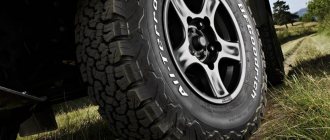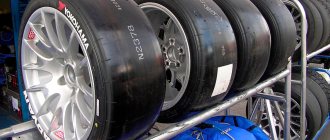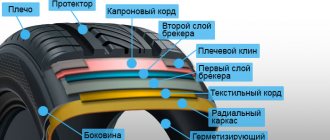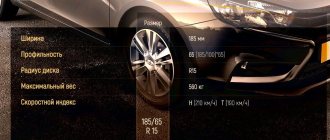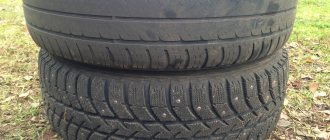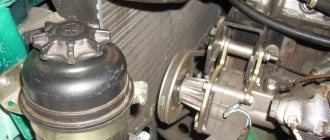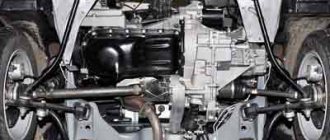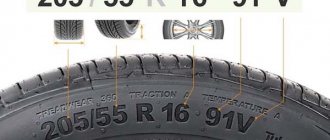Are you looking for a decoding of tire seasonality? The article contains a complete explanation of the seasonality designation on winter, summer and all-season tires.
Seasonality of tires is divided into: summer, winter and all-season. Summer, winter and all-season tires differ in parameters and many characteristics that affect the safety and comfort of movement. Being able to differentiate between different models is extremely useful because it makes it easier to choose the right type of tire. Below you will learn how to distinguish winter and all-season tires from summer tires and what are the characteristics of individual types of tires designed for certain seasons.
To indicate the seasonality of tires, the following markings are used:
- 3PMSF - a snowflake symbol against a background of three mountain peaks;
- M+S is an abbreviation for Mud+Snow, translated from English as “mud + snow”;
- AS, Any Season, All Season, R+W, AW, AGT - type of all-season tires;
- Rain, Aqua, Water, Aquatred, Aquacontact or painted umbrella are a type of rain tire that is suitable for driving on wet roads.
All designations on the sidewall of automobile tires, or rather the tire markings, are a set of technical parameters and other useful information indicating: date of production, country and manufacturing company, size, maximum permissible speed and load, type, installation method, operating conditions and seasonality.
Tires for any season. Is it possible?
All-season tires combine the characteristics of summer and winter tires. It saves the driver from seasonal changes, but it is a mistake to think that it can be used instead of full-fledged winter and summer tires.
These tires are designed for countries with mild climates, where the air temperature in winter does not drop below – 7 °C, and the summer heat is kept within reasonable limits (no more than +25 °C).
Winter tires have a high tread that protects from snow and deep grooves to drain water. Summer tires provide good grip due to a large contact patch with the surface.
Winter tires are softer and do not “tan” in severe frost, while summer tires are stiffer and do not melt under high temperatures.
The combination of these completely opposite qualities in one product is impossible, so all-season tires can only be used in temperatures ranging from -5...-7 °C to +25...+27 °C.
Summer tire in winter
These are tires for extremely warm temperatures, they should be rigid and relatively light, they should not have a rough and high tread, but effectively remove moisture. A hard tire in summer is a salvation, it “doesn’t melt or float” at above-zero temperatures, hard compounds are used to the maximum, heating up from hot asphalt, the tire effectively engages with the road surface, and there is no increased wear. However, in winter (already at zero), such rubber begins to harden, in addition to the fact that it itself is “hard,” under the influence of negative temperatures it becomes even harder, the tread cannot effectively adhere to the road surface (it practically does not wrinkle), and Even more so when dealing with snow or ice, such a tire literally rolls like “on skates”, the braking distance increases and the grip on the road deteriorates.
Basic parameters of all-season tires
Rubber, which can be used all year round, is made from the same materials as seasonal ones:
- rubber;
- carbon black;
- resin;
- various fillers, which may differ in composition from different manufacturers.
Related link:
Cordiant Snow Cross and Kama Euro 519: which is better?
The difference is only in the percentage of these materials. All-season tires contain less rubber than winter tires and have average hardness.
The tread has a height of 7.5 to 9 mm.
Modern models of all-season tires in most cases have an asymmetric tread pattern.
It consists of two parts:
- External part. Its working surface resembles winter tires, as it consists of polygonal sectors.
- Inner part. It has a directional structure designed to drain water, similar to summer tires.
This type provides effective grip on wet road surfaces and stable control in light frosts (up to -7 °C)
Advantages and disadvantages of all-season tires
The pros and cons that tires of this type reveal during operation:
| Advantages | Flaws |
| 1. There is no need to seasonally change tires and store a second set. 2. Saving money on buying a second set. 3. Good handling on wet asphalt. | 1. Poor handling and maneuverability in winter. 2. Severe wear at high temperatures (more than + 25 °C). 3. Increased fuel consumption at high temperatures. |
Tread
Difficult choice
Tire technology does not stand still. Just 10 years ago it would have been difficult to imagine that even with a completely punctured tire you could safely continue driving without slowing down too much. Or that on winter tires without studs you can move quite confidently on snow or ice.
A tire is just a piece of rubber wrapped around a rim. This is a high-tech product, the quality of which may depend on your life.
Carefully choose new tires for your “iron” horse, since today there really is a lot to choose from. Be sure to follow the rules for installing and operating tires, do not neglect their seasonal changes, and your wheels will stick to the road with all their might.
Source
All-season tire manufacturers
Well-known manufacturers of all-season tires:
- Hankook;
- Michelin;
- Bridgestone;
- Yokohama.
All-season tire from Continental
All-season tires Bridgestone Dulere 840
The first all-season tires began to be produced at the Goodyear plant in the USA. The company still holds a leadership position in this segment and provides the widest range of all-season tires.
Manufacturers' information or logo is applied to the side of the wheel. Its model is also indicated here, and the country of origin is written closer to the rim, in smaller font.
Load index
Along with the speed category, tire manufacturers put down two more numbers - the maximum load index. This parameter means that the tire is capable of traveling under the specified weight on one wheel, subject to maximum pressure. The indicator is indicated in kilopascals closer to the inner radius.
The higher the indicator, the greater the load that the wheel can carry. The minimum value in the industry is 1 - 46.2 kg per wheel, and the maximum figure is 279 - 13.6 tons per cylinder.
Main characteristics: size, profile, type and design of the tread
All-season tires, like regular tires, have the following parameters:
- Profile. The width and height indicators are taken into account. The width is in millimeters, and the height is a percentage of the width. For example, 205/55, where 205mm is the width of the tire, and 55 is % of 205, that is, 92.25 mm.
- Diameter of the seat. Measured in inches and depends on the car model. It is marked on the side of the wheel in the form of numbers (13, 15, 20, etc.).
- Design. It can be diagonal (rarely used) and radial. Denoted by the letters D and R respectively..
- The side is indicated on the asymmetrical treads. Marked with the inscriptions Inside and Outside. Directional wheels have an arrow indicating the direction and the words Rotation.
- Temperature conditions. Indicated in the letters A, B and C, where A is the best indicator of heat resistance at high speeds.
- Maximum pressure. Expressed in kilopascals or bars.
Related link:
TOP 10 budget tires for winter 2018-2019
Special badges on all-season tires
External side marking
The manufacturer can apply to all-season and other additional descriptions, for example, the material from which the cord is made (nylon, polyester, steel) or the wear resistance of the rubber, which is expressed in numbers from 100 to 500.
Speed table
Speed indicators are indicated by letters. The marking indicates the ability of the tires to reach a particular speed.
| Maximum speed (km/h) | Speed index |
| 120 | L |
| 130 | M |
| 140 | N |
| 150 | R |
| 160 | Q |
| 170 | R |
| 180 | S |
| 190 | T |
| 200 | U |
| 210 | N |
| 240 | V |
| 270 | W |
| 300 | Y |
| More than 300 | Z |
Tire load table
The load index determines the carrying capacity of the vehicle
| Index | Weight, kg | Index | Weight, kg | Index | Weight, kg | Index | Weight, kg | Index | Weight, kg |
| 62 | 265 | 75 | 387 | 88 | 560 | 101 | 825 | 114 | 1180 |
| 63 | 272 | 76 | 400 | 89 | 580 | 102 | 850 | 115 | 1215 |
| 64 | 280 | 77 | 412 | 90 | 600 | 103 | 875 | 116 | 1250 |
| 65 | 290 | 78 | 425 | 91 | 615 | 104 | 900 | 117 | 1285 |
| 66 | 300 | 79 | 437 | 92 | 630 | 105 | 925 | 118 | 1320 |
| 67 | 307 | 80 | 450 | 93 | 650 | 106 | 950 | 119 | 1360 |
| 68 | 315 | 81 | 462 | 94 | 670 | 107 | 975 | 120 | 1400 |
| 69 | 325 | 82 | 475 | 95 | 690 | 108 | 1000 | 121 | 1450 |
| 70 | 335 | 83 | 478 | 96 | 710 | 109 | 1030 | 122 | 1500 |
| 71 | 345 | 84 | 500 | 97 | 730 | 110 | 1060 | 123 | 1550 |
| 72 | 355 | 85 | 515 | 98 | 750 | 111 | 1090 | 124 | 1600 |
| 73 | 365 | 86 | 530 | 99 | 775 | 112 | 1120 | 125 | 1650 |
| 74 | 375 | 87 | 545 | 100 | 800 | 113 | 1150 | 126 | 1700 |
General concepts
So, we open the owner's manual to find out what tires we need to buy. Here we find tire options for different conditions. They depend on the following indicators:
- Season – tires are available in summer, winter and all-season;
- Engine – type of power plant and its power;
- Discs - rubber is selected depending on the material from which the discs are made.
Tire markings are applied to all tires. From it you can find out the size, speed and load index, as well as the manufacturer. A tire consists of a bead, carcass, side part, tread and breaker layers. If you turn the side of the tire towards you, you will see the markings on the tires in the following sequence: width, profile and diameter. The example below shows a tire with a width of 225, a profile of 45Z and a diameter of R17:
Marking of all-season tires. Analysis by example
All-season tires are usually marked with the inscription AllSeasons (abbreviated as AS). Sometimes you can see the designation of all-season tires on tires
like AnyWeather or AllWeather, which is basically the same thing. It is also indicated by graphic drawings:
Related link:
Nokian Nordman 4 - a classic of winter tires
All-season designation on the sidewall
Let's look at the designations of all-season tires using an example. For analysis, let’s take tires with the following parameters:
LT 275/70 R18 124 Q, Tubeless, All weather,Right
- LT stands for Light truck and is used in American markings. European tires will not have this inscription;
- 275/70 – rubber profile. Width 275 mm, height 70%;
- R – radial structure of the tire;
- 18 – landing diameter;
- 124 – load index, which means that the load capacity is 1600 kg;
- Q – maximum permissible speed on this tire is 160 km/h;
- Tubeless - tubeless tire;
- Allweather - all-season;
- Right – asymmetrical, directional.
Explanation of markings
Cost of all-season tires. Does price affect quality?
Let's look at several tire models from well-known manufacturers.
| Advantages | Flaws | Cost (in dollars) | |
| Pirelli Scorpion Verde AllSeason | · Low cost · Resistant to aquaplaning (sliding on wet asphalt) · Short braking distance Low noise | · Poor handling in icy conditions · Not suitable for off-road use | 70-80 |
| Hankook DynaPro ATM RF10 | · Low cost · Good grip on any type of surface Controllability · Quick response to brake and gas pedals | · Vulnerable sidewall · Poor cross-country ability in mud and clay | 70-80 |
| Goodyear Vector 4 Seasons | Silence · Fuel economy · Good stability and grip Short braking distance on dry surfaces | · Low cross-country ability and long braking distances on snow · High cost | 107-115 |
| Dunlop Grandtrek AT22 | · Fast braking on any type of surface · Exchange rate stability Cross-country ability and controllability on snow Durability and side cut protection | · More like winter tires · Cannot withstand high temperatures · High price | 120-130 |
Related link:
Winter tires Kama 505 Irbis - the optimal combination of price and quality
* Prices are current as of October 22, 2018.
Goodyear Vector 4 Seasons tire
Tires from the expensive category are usually of higher quality, but in some respects they may be inferior to average or even budget ones. Therefore, when choosing, it is important to focus on the type of all-season tires and indicators that are relevant for a particular vehicle and its operating conditions.
Drivers' reviews of all-season tires
| Positive | Negative |
| I've already driven the Dunlop Grandtrek for 85 thousand km without changing shoes. It behaves perfectly on any road, both dry and wet. My opinion is that if you take an all-season tire, then only an expensive one, then there will be an effect. | When I bought tires, the sellers talked me into all-season tires. They just forgot to say that already at +20 fuel consumption increases significantly. The rubber becomes soft and prevents rolling. My car's consumption has increased by almost a third. At current gasoline prices, this is very unprofitable. |
| Our climate is warm, frosts are rare, so I bought all-season tires last year. After winter use I can say that they work great. Of course, they are inferior to winter ones, but they hold the road well. If you drive calmly, there will be no problems. I don't know how she will behave in the summer, but so far I'm happy. | All-season tires are not suitable for our climate, no matter how you look at them. In winter it slips, in summer it makes movement difficult. My Qashqai came with all-season tires from the factory, so I had to buy winter tires. I thought about driving my relatives in the summer, but in the heat they also behave poorly, the car immediately loses speed, but increases in consumption. |
| I installed Yokohama Geolandar tires on the X-Trail. Friends actively discouraged me from using all-season racing, but I took the risk. I want to say that all my fears were in vain. In summer it does not float, in winter the control is normal. Braking is also ok. | I bought a car with all-season tires. Even though I have a lot of driving experience, driving it is very dangerous. You can never predict how he will behave. And the car drives very hard in all-season driving. When I installed it in normal winter, I immediately felt the difference. |
| I drive mostly around the city, and if it gets very snowy, I have the opportunity not to leave at all until the roads are cleared. That's why I bought all-season tires. No problems with changing shoes or storing them, I can ride with peace of mind until they wear out. | If you count all the shortcomings, it turns out not economical. All-season tires wear out faster and are not cheap. It cannot be driven in severe weather conditions. I personally swapped out the factory all-weather tires for winter and summer tires. |
Related link:
Review of tire tests in size 175/65 R14.
* Reviews taken from the sites: https://www.expertcen.ru/, shiny-diski.com.ua, https://7fm.by/, infoshina.com.ua.
Is it worth buying an “all-season” set, or is it better to have two standard sets?
It is advisable to use all-season tires all year round in the following cases:
- If in your country winter temperatures do not fall below 0 °C and the heat does not exceed +25 °C.
- If you rarely travel by car and can leave the car in the garage when weather conditions are not suitable for comfortable movement.
You should use such tires only in suitable temperature conditions, and under no circumstances should you ride on all-season tires in a snowstorm, ice or thirty-degree heat, as this may be unsafe.
In Russia, Ukraine, Kazakhstan and other countries with a similar climate, you must have a set of winter and summer tires. It must be replaced in accordance with weather conditions (from +5...+7 °C).
Where to begin
The vehicle's owner's manual usually contains some recommendations for the correct selection of tires. This takes into account the type of wheels (steel or alloy), season of use (summer, winter), as well as the standard factory size. Naturally, not every driver adheres to such recommendations, which is why the car may be equipped with tires that, in terms of their parameters, do not meet the requirements of the manufacturer.
So it’s better to start by studying the standard requirements for tires of a certain brand of car. If you are satisfied with the type and size of the tires that are installed on the car, you simply need to rewrite all the existing designations.
